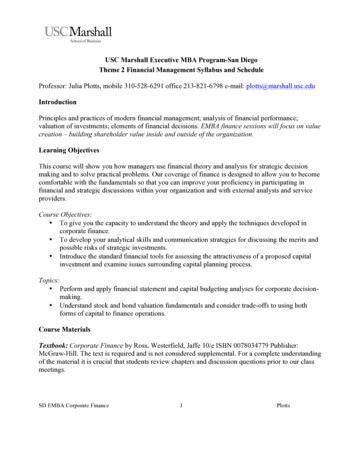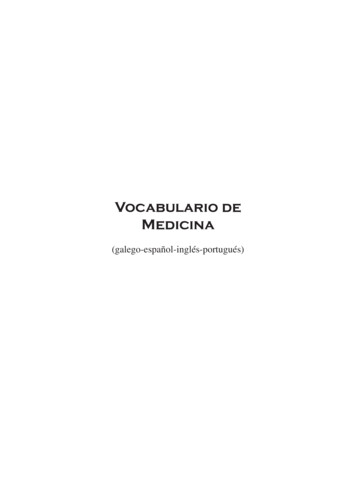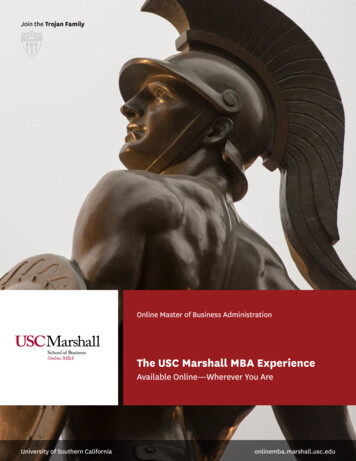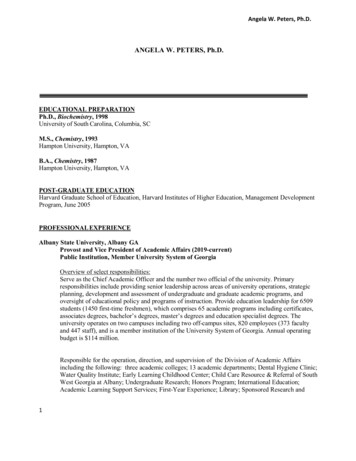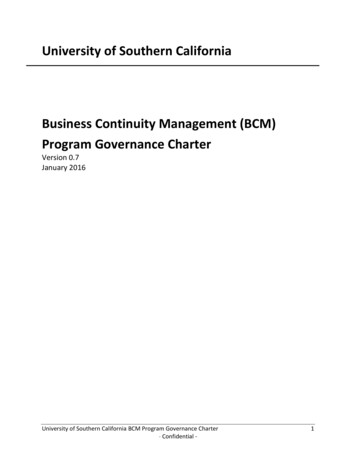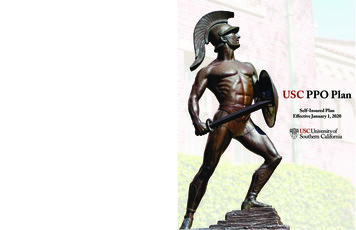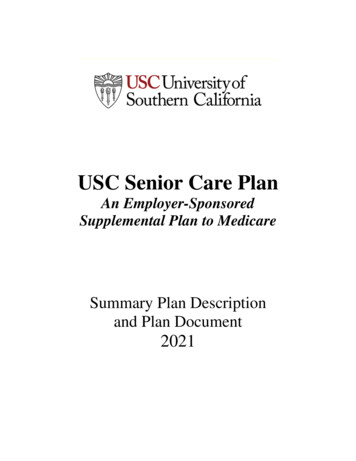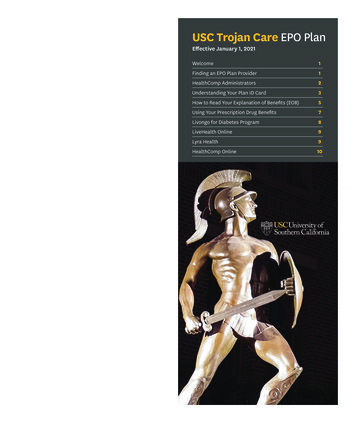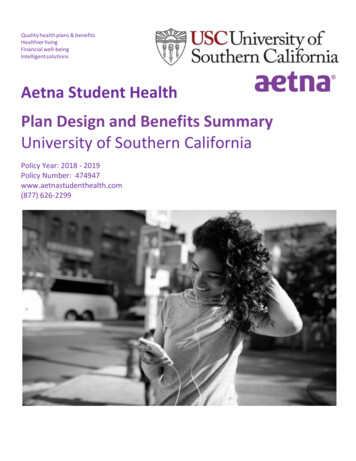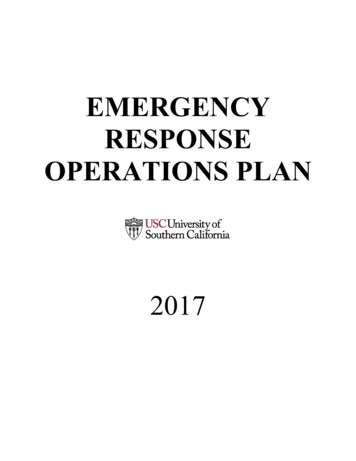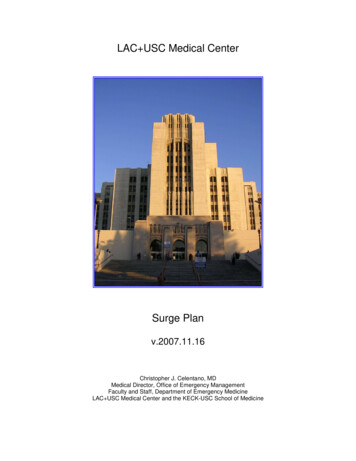
Transcription
LAC USC Medical CenterSurge Planv.2007.11.16Christopher J. Celentano, MDMedical Director, Office of Emergency ManagementFaculty and Staff, Department of Emergency MedicineLAC USC Medical Center and the KECK-USC School of Medicine
TABLE OF CONTENTSSurge PlanPurpose . . .1Policy . . . 1Policy References . 1Definitions 2.Procedure . 3Response Threshold (NEDOCS) . 3Response Matrix . . . 4Not Busy . 5Busy . . 9Overcrowded . .10Severely Overcrowded .12Dangerously Overccrowded .14PFM Guidelines and Transfer Protocols . 17Full Capacity Protocol: Acute Care Units . .23Full Capacity Protocol: Intensive Care Units . .26Surge Plan DiscussionDiscussion . .29Perspective on the Inpatient Bed Crisis .29The Official Mandates 30Surge Concepts .32ED Overcrowding .32Surge Plan Elements .33Conclusion .37References (Endnotes) . . .38Attachments:Hall Bed WorksheetsMAC PFM Algorithmi
The Surge PlanSUBJECT:The LAC USC Medical Center Healthcare Surge Plan.DEPARTMENTS:Hospital wide.PURPOSE:To establish a system-wide approach to healthcare surge response capability in order to effectively andappropriately accommodate patient needs, manage healthcare emergencies, and mitigate disasters.POLICY:The plan provides a methodology to maximize healthcare capabilities in response to patient influx byencompassing a continuity of operations from open hospital status, to full capacity, to overcrowding, andto surge capacity.The plan is not an emergency operations plan. It is a daily operational plan, elements of which are anintegral part of the overall emergency operation plan.The plan will utilize an objective measure of Emergency Department and Hospital Overcrowding that willautomatically dictate a network response. This utility is designed for rapid notification and planimplementation No further administrative approval will be required since, as a Network Policy, theapproval is inherent.The plan incorporates new and existing operational policies and procedures to provide a cogent andcomplete reference tool. It references and abides by existing regulations, standards, and guidelines forhealthcare surge and emergency (disaster) preparedness.The plan provides mandatory response guidelines that are to be adhered to by all referenced individualsand departments involved in the response.The plan is not static but dynamic. It designed to be updated, improved, and refined to best maximize thedelivery of patient care through all levels of patient surge and fluxing hospital capacity.POLICY REFERENCES:CA DHS All Facilities Letter 04-28: Increased Patient Accommodations Due To Seasonal or UnexpectedHigh Influx of Patients, California DHS.CA DHS All Facilities Letter 05-04: Licensed Nurse-to-Patient Ratio, California DHS.California Code and Regulations Title 22: 70809, 70217.LAC DHS Facility Letter 11-10-03: Ref. No. 304, Guidelines for Acceptance of Emergency DepartmentTransfers of Patients with an Emergency Medical Condition.LAC DHS Facility Letter 11-20-03: Revised procedure for Transfer of Emergency Department Patients toCounty Operated Facilities.LAC DHS Reference No. 304: Guidelines for Acceptance of ED transfer of Patients with an EmergencyMedical Condition.LAC DHS Reference No. 305: Guidelines for Acceptance of ED transfer of Patients without anEmergency Medical Condition.LAC DHS Reference No. 306: Guidelines for Acceptance of Stable Inpatient Transfers.1
The Surge PlanLAC DHS Policy 373.1: Emergency Transfer Authorization County Code 2.76.53.LAC DHS Policy 503: Guidelines for Hospitals Requesting Diversion of ALS Patients.LAC DHS Policy 503.1: Hospital Diversion Request Requirements for ED Saturation.LAC DHS Policy 911: Role of DHS Employees in the Event of an Emergency.LAC USC Healthcare Network Attending Staff Manual.LAC USC Healthcare Network Policy 134: Increased Patient Accommodations Due to High Influx ofPatients.LAC USC Healthcare Network Policy 705: Transfer of Patients to LAC USC Healthcare Network.LAC USC Healthcare Network Policy 705.1: Transfer of Patients from the Network to Another Facility.LAC USC Healthcare Network Policy 706.1: Guidelines for Acceptance of Patients with an EmergencyMedical Condition.LAC USC Healthcare Network Policy 706.2: Guidelines for Acceptance of Patients without anEmergency Medical Condition.LAC USC Healthcare Network Policy 706.3: Guidelines for Acceptance of Stable Inpatients toLAC USC Medical Center.LAC USC Healthcare Network Pandemic Flu Plan: Plan for Management of Influx of People withInfectious Diseases.DEFINITIONS:Acute Care Unit (ACU): non-monitored inpatient ward beds, i.e. medical / surgical ward beds.Disaster: an event that exceeds the capabilities of the response.1. A disaster exists when need exceeds resources (Disaster Needs Resources).2. A disaster exists when the number of patients and/or severity of illness or injury are such that1normal daily operations are no longer possible.ED Overcrowding: a situation in which the identified need for emergency services outstrips available2resources in the ED.Healthcare Emergency: an unpredictable or unavoidable occurrence at unscheduled or unpredictable3intervals relating to healthcare delivery requiring immediate medical interventions and care.Mass Casualty Incident (MCI): an event that exceeds the healthcare capabilities of the response. An1MCI exists when healthcare needs exceed resources.NEDOCS: National Emergency Department Overcrowding Scale.Surge: a sizeable increase in demand for resources compared with a baseline demand. Componentsinclude Influx (volume, rate), Event (type, scale, duration), and Resource Demand (consumption,degradation).Surge Capacity: the maximum potential delivery of required resources either through augmentation ormodification of resource management and allocation. Components include System (integrity), Space(size, quality), Staff (numbers, skill), and Supplies (volume, quality).Surge Response Capability: the ability of Surge Capacity (the resources that can be made available) to4accommodate the Surge (demand for resources).2
The Surge PlanPROCEDURE:A. Response ThresholdThe NEDOCS will be used as an objective measure of emergency department and hospital overcrowding.Studies have demonstrated that this system is an effective measure of overcrowding including large5 6 7 8 9 10academic centers that are frequently overcrowded.The calculator uses variables found to bestatistically significant in emergency department overcrowding, and the “score” corresponds to a givenlevel of operational capacity.The calculator is available at http://hsc.unm.edu/emermed/nedocs fin.shtml, and uses the equation:Score -20 85.8(c/a) 600(f/b) 13.4 (d) 0.93(e) 5.64 (g)The institutional constants are: a) Number of ED Beds.b) Number of Hospital Beds.The situational variables are:c) Total Patients in the ED.d) Number of Respirators in Use in the ED.e) Longest Admit Time (in hours).f) Total Admits in the ED.g) Wait Time for the Last Patient Called (from triage).ED and hospital beds are the budgeted number of beds available for patient care. Total patients in theED include normal, doubled-up, and hallway beds, and those undergoing work-ups in chairs, triage,waiting room, etc. If using the website calculator, the score is displayed as 0 – 200 (the upper limit of thecalculator is 200 even though the calculation may be 200). The corresponding operational capacity willbe interpreted as follows:Overcrowding ScaleNEDOCSScore0 – 5051-100101-140141-180 180ConditionNot vercrowdedIt should be noted that the published NEDOCS has six levels and differs as follows: “Not Busy” (Green) is0-20, “Busy” (Light Green) is 21-60, “Extremely Busy” (Yellow) is 61-100. For our purposes, these 3levels are consolidated to the 2 levels as shown above. The total range for these combined levelsremains the same. Since we are a large institution with significant capability, that extra delineation willnot change operations.As standard procedure, the ED will assess conditions every 2 hours. The NEDOC score will becalculated. If the level changes, the ED will use the Emergency Notification System to alert theappropriate, pre-designated personnel. A notification matrix will be established for this purpose and willinclude those components of Hospital Administration, Nursing, Medical Staff, and Ancillary Services thatrequire notification and / or are an integral part of the response. The appropriate personnel are, thus,notified. Approval for proceeding with the mandated response is inherently given. The Medical Centerwill automatically respond with the appropriate intervention as described below.3
The Surge PlanConditions that will supersede the calculator include a medical, trauma, or CBRNE Mass Casualty Event(MCE) or an internal/external disaster in which case the status will be elevated to BLACK until that timethat the event has resolved and the network has returned to normal operations.B. Response MatrixEach level corresponds to and necessitates an institutional response with respect to systems (i.e.functional and departmental operations), space (bed capacity, utilization, and conversion), staff(responsibilities and operations), and supplies. As the overcrowding increases, the degree of responseescalates to prevent or mitigate further overcrowding and the consequences of such. Responseguidelines will continue into the next level unless a change is specified.The first level is Green (“Not Busy”). The level of overcrowding is self-explanatory. This level requiresstandard operational procedures to be in effect, elements of which are to emphasize their importance inmaximizing efficiency on a routine basis in order to improve hospital throughput which will decrease theoccurrence of ED and hospital overcrowding, and, ultimately, improve patient care. The second level isYellow (“Busy”). Since this is a large institution with significant capacity, little changes in the guidelines.The third level is Orange (“Overcrowded”) which is analogous to being closed to ED Saturation. Thefourth level is Red (“Severely Overcrowded”) which is analogous to Code Overload. These terms,however, will no longer be used to describe the level of overcrowding or the level of response. The fifthlevel is Black (“Dangerously Overcrowded”). This is the high extreme of overcrowding. Additionally, it isused for MCI’s and internal/external disasters.The following table details the response. The colored bar on the left indicates the level. The body detailsthe specifics.4
The Surge PlanRESPONSENOTBUSYDEM RESPONSESystem1. Standard operating procedures in effect.2. EMSa. ED Diversion Status: Open.b. ED Charge Nurse / MICN will update ReddiNet as needed.3. Fast Track of appropriate triage patients to UADC or UADC Appointment as indicated.4. Area Attendings and Nurse Managers continually round to evaluate the work load andproductivity of the areas and redistribute patients and staff as indicated.5. Continual and periodic physician assessment of triage patients with work-up and treatmentinitiated as necessary.6. ED Observation Area (1200) utilized for appropriate patients to make available acutetreatment beds.Space, Staff, Supplies1. Standard operating procedures in effect.MEDICAL CENTER RESPONSESystem1. Standard operating procedures in effect.2. Admissionsa. Inpatient beds assigned per protocol.b. Service restrictions authorized.i. Specialty services consulted for appropriate patient admits.ii. Specialty services will take such patients on their service ward if a bed isavailable.c.The ED Attending has authority to admit patients to any service of the hospital inaccordance with the general policies of the hospital and its various departments.d. The ED Attending can determine the appropriate level of inpatient care required foran admission.i. If and when the hospital establishes official guidelines delineating patientcriteria for specific inpatient units, these guidelines will be evidence-basedand reflect accepted standards of care.5
The Surge Plan3. Transfers: See PFM Guidelines and Transfer Protocols for detailed description. Protocolsinclude:a.The PFM will evaluate and arrange all EMTALA transfers through the MAC per DHSMedical Alert Center Reference No. 304-6.b.NO hospital physician shall accept a transfer request from an outside physician. Acounty physician who receives a call directly from a private hospital physician topresent a transfer request should advise the private hospital physician to coordinatethe transfer through the MAC.c.The MAC will contact the Patient Flow Manager at potential receiving hospitals todetermine hospital capacity and, if accepted, arrange transfer.See MAC PFMAlgorithm.d.If the Hospital has capacity, the PFM will present the transfer request to theAttending (or Senior Resident in consultation with the Attending) of the appropriatespecialty service. If the transfer is accepted, the patient will be assigned to thatphysician / team accepting the patient. The open bed will be assigned to and heldfor that patient.e.Upon arrival of the transferred patient to LAC USC:i. ED to ED transfers will come to the ED.ii. ED to IP and IP to IP transfers:a. Will NOT go through the ED. The one exception is the Orthopedicpatient.b. Will be taken directly to the admitting nursing unit, evaluation clinic(OMF, ENT, Ophthalmology, Urology, Burns), or 1434 dependent onthe clinical service and the patient’s medical condition.iii. The accepting team will be the primary team assigned to the patient and willbe immediately responsible for the patient’s care upon the patient’s arrival tothe hospital.a. If, when the transfer arrives, the accepting physician / team whowere on-call are no longer at the hospital, the responsibility for thatpatient’s care is the current physician / team on-call for that service.b. If the accepting team determines that the patient’s condition requirescare by additional services, these specialties will be consulted.c. If the accepting team determines that the patient’s condition requirescare by a different service, this specialty shall be consulted and, ifnecessary, care transferred per guidelines set forth in the AttendingStaff Manual.4. In-patient Medical Staff and Specialty Service Operationsa. Inpatient Rounds: Early rounding and discharges are necessary to maximize theefficiency of hospital throughput and maintain bed availability. Therefore, time ofinpatient rounds and discharges will be adhered to by all inpatient services and toinclude:i. Inpatient pre-rounds by 0700.ii. Inpatient attending rounds by 0900.iii. Morning discharge orders by 1100.6
The Surge Planb. Discharge Waiting Unit (DWU):i. To be utilized by inpatient services for ALL appropriate discharges, i.e. theDWU is open 0600-2330 and criteria includes self-sufficient and stablepatients without the need for contact isolation.ii. The simple orders are as follows: “D/C IV, D/C home, D/C to DischargeWaiting Unit”.c.IM Hospitalist: In order to maximize the effectiveness of the Hospitalist, the InternalMedicine and Medical Staff Office are to provide a detailed Hospitalist work scheduleand job description to be included in this document and should include, but not belimited to:i. Direct care of adult non-surgical hospitalized patients.ii. Staffing the Med Consult Resident for hospitalized non-medical patientconsults, the short stay unit, and ED admissions.iii. Supervision of on-call ward teams to streamline admissions, evaluation,treatment, procedures, and discharges.1. Conduct evening rounds with ward teams. These should be brief,problem-based bedside rounds to address urgent patient careissues.2. Supervise and train on-call ward teams in specialty activities andprocedures.3. Supervise on-call ward teams to expedite the evaluation, treatment,and plan for new admissions.4. Reassess ward patients and their status for potential discharges.iv. Coordinate and assist in streamlining ED admissions by identifyingappropriate discharges and identifying empty beds.v. Assist ward teams in coordinating the patient care activities of nursing andsupport staff.vi. Assist ward teams in coordinating specialty care as required.d. Emergency Consults from Specialty Services.i. Specialty services must respond within 1 hour of request.ii. Specialty services must re-evaluate every 24 hours (at a minimum), thosepatients with active issues who remain in the ED awaiting admission.5. Unit Operations: This category includes Acute Care Units (ACU), Intensive Care Units(CMA/PMA/ICU), Observation Areas (1202), Emergency Evaluation and Treatment Areas(ENT/OMF 4130, Ophthalmology/Urology 4628), Operating Rooms (OR), and Post-operativeArea Rooms (PAR).a. Units will expeditiously process discharges and prepare bed for new occupancy.b. Units will not misrepresent bed status.c. Units may not refuse report from the ED.d. Units may not refuse an admission or transfer from the ED.e. Units will assist ED transport teams when patients are delivered to their respectiveunits.f. Units may not transfer or return patients to the ED.6. CMA/ICU-Specific Operations: see PFM Guidelines and Full Capacity Protocol: CMA/ICU’sfor detailed guidelines.7
The Surge Plan7.Diagnostic Services Operationsa. Radiology:i. Cannot refuse imaging requests for emergency studies.ii. Must provide final Attending reads of emergency imaging studies within 2hours of study completion 24/7/365.Space1. Standard operating procedures in effect.Staff1. Standard operating procedures in effect.2. Ancillary Servicesa. The 1350 Separation & Admission Clerk Post shall be staffed 24/7/365.3. Medical Staffa. For Attending Staff with dual obligations: if you are a County or USC physicianprimarily based at LAC USC Medical Center or if you are the responsible ServiceAttending at a given time, then your primary obligation is to LAC USC MedicalCenter and its patients.i. This mandates the physician to comply with these guidelines and to bephysically present at the Medical Center to carry out such duties.ii. Prior arrangements with a physician’s partners in an outside group should bemade to allow for the performance of these duties.4. Nursing Servicesa. Administration must staff “beds ahead”. The HMO driven practice of staffing for bedsas patients are admitted has contributed to the inpatient bed crisis. Administrationwill take pro-active measures to staff beds ahead, ensure open beds, andexpeditiously receive admitted patients. This practice will decrease ED boarding ofadmitted patients and the poorer outcomes associated with such.5. Diagnostic Servicesa. Radiologyi. To staff technicians for Ultrasonography 24/7/365.ii. To staff technicians for CT to ensure that, at a minimum, 2 scanners are inoperation 24/7/365.Supplies1. Standard operating procedures in effect.2. Critical to the response capability of the ED is the proximity and availability of designated EDequipment.a. No Unit or Service shall sequester ED equipment for their own use.b. Any ED equipment found outside the ED will be returned to the departmentimmediately.c. Such equipment includes and is not limited to gurneys, mechanical ventilators, bipapventilators, monitors, defibrillators, transvenous pacemakers, intubation equipment,thoracotomy equipment, etc.8
The Surge PlanBUSYDEM RESPONSESystem, Space, Staff, Supplies1.No interval change.MEDICAL CENTER RESPONSESystem1. Admissionsa. Specialty Services may reserve 1 female and 1 male bed per service.Space, Staff, Supplies1. No interval change.9
The Surge PlanO DEM RESPONSEVE SystemRC1. EMSRa. ED Diversion Status: Closed.Ob. ED Charge Nurse / MICN will update the ReddiNet as needed.WD2. AdmissionsEa. The ED
LAC USC Medical Center Surge Plan v.2007.11.16 Christopher J. Celentano, MD Medical Director, Office of Emergency Management Faculty and Staff, Department of Emergency Medicine LAC USC Me
